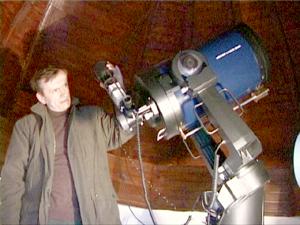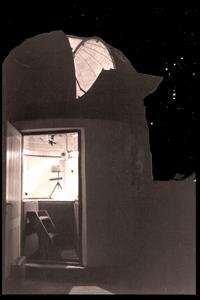Regional Computer Laboratory for Teaching Natural Science
The Laboratory has been built by the University of Białystok in co-operation with the Białystok section of Polish Physical Society. The goal of the laboratory is to teach Natural Science (mainly physics) and to incorporate computers into the teaching process. From the Laboratory benefit university students as well as teachers and learners. The Laboratory consists of two sections, which are located in separate rooms. One section deals with computer aided physical experiments, whereas the other - with numerical simulation of physical processes and programming teaching. The Laboratory is directed at educating firstly university students and secondly - secondary school students and teachers. A dozen or so people can work there on individual experiments or numerical simulations at the same time. Kits for carrying out experiments, as well as computer programs, are also applicable during lectures (the overhead liquid crystal projector is of great use here). The creation of the Laboratory was supervised by the staff of the Magnetic Physics Unit of the University of Białystok. Also, the university students greatly contributed to the Laboratory. Several measuring sets were assembled by local secondary school students.
Both sections of the Laboratory are operated by the 366 MHz IBM PC server, 22 GB HDD, 160 MB RAM, HTTP server (Apache), e-mail server, file server for the local network of diskless workstations.
Lab A - Computer aided physical experiments
The laboratory consists of 10 PC computers working under Win95, Win98 and DOS operating systems. Additionally, workstations are equipped with sound cards, TV/FM cards, various measuring interfaces, including:
Locally designed interfaces of three kinds: with
digital input/output, parallel-port based and PIC17C756
microprocessor based;
Interfaces from the Dutch CMA Foundation (UIB and
Coach Junior CMA);
PASCO Company;
COBRA (PHYWE).
Several dozen probes that make it possible to measure position of various objects, acceleration, force, angle, light intensity, magnetic field, temperature, sound intensity, pressure, a, b, g radiation, pulse, pH, etc. Various measuring sets, as well as parts that allow the construction of new sets, made by LEYBOLD, PASCO, PHYWE. Scanner, CCD cameras and other equipment.
Software: LabView, Coach, Coach Junior, Cobra RTG, Scientific Workshop, etc.
The list of computer aided experiments (some of them are under development):
During the Meeting, visitors to the Laboratory could carry out experiments
chosen from the list above. A measuring set enabling, through the Internet,
research on magnetization processes and investigation of the domain structure
in thin magnetic films was available at the Laboratory for ten days.
 The
Laboratory activities include astronomical observations with the use of
computers (a 12" telescope with a CCD camera has been bought and put into
service; the telescope and the camera can be operated by a computer; also
digital acquisition of data is possible). It is planned to incorporate
the telescope into the worldwide web of small laboratories detecting variable
stars, ASAS. In the future, the telescope will be commonly available through
the Internet.
The
Laboratory activities include astronomical observations with the use of
computers (a 12" telescope with a CCD camera has been bought and put into
service; the telescope and the camera can be operated by a computer; also
digital acquisition of data is possible). It is planned to incorporate
the telescope into the worldwide web of small laboratories detecting variable
stars, ASAS. In the future, the telescope will be commonly available through
the Internet.

Lab B numerical simulations of physical processes
The laboratory includes ten IBM PCs with Pentium Celeron 350 MHz processors, configured as diskless workstations, served by Debian Linux operating system. In this section of the Laboratory we use, among others, programs created within the American CUPS project, as well as the newest version of the Mathematica package, which is commonly used at the University of Białystok for scientific research in the field of theoretical physics and for teaching computer subjects.
The Mathematica package, which has been being developed by Wolfram Research, Inc. for over ten years, is a refined tool for programming complex symbolic calculations. The package differs from 'typical' programming languages in that, among others, it possesses a wide variety of functions performing symbolic operations (integrating, power series expansion, solving of algebraic and differential equations, advanced transforming of algebraic expressions), and also in that it operates on numbers of arbitrary precision. Among other advantages of the package is convenient graphical visualization of data and advanced techniques of manipulating lists of elements of any type.
In our Department, the Mathematica package is commonly used in scientific research, especially by those academics who specialize in theoretical physics. We use the package in Windows and Unix environment. In 1995 the Institute hosted an international workshop ?Mathematica and Form in Education and Science? devoted to possible applications of Mathematica package.
For several years our Department has been offering laboratory classes to first years students. The classes concern employing Mathematica package in mathematics and physics. During the classes, students deal with problems typical to analysis, linear algebra, and number theory. Programs written in Mathematica package are used in discussing many basic questions concerning classical mechanics or wave motion. The syllabus also includes elements of programming, emphasizing the programming techniques typical to Mathematica package.
Within the CUPS project, there have been launched several dozen demonstrative programs that model various phenomena in the most important branches of physics. The subject matter and the level of the whole series are adjusted to the syllabus of the primary university courses. The programs, most of whose authors come from American academies, have been written in Turbo Pascal.